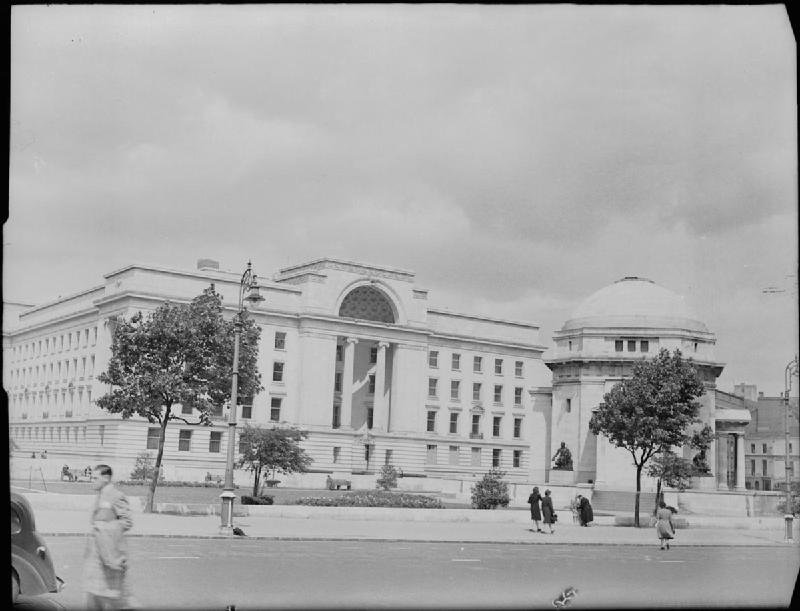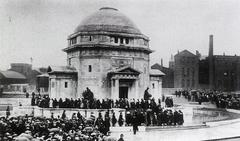
Hall of Memory Birmingham: Visiting Hours, Tickets, and Guide to Historical Sites
Date: 15/06/2025
Introduction
The Hall of Memory in Birmingham stands as a solemn tribute to over 12,000 citizens who sacrificed their lives in World War I and subsequent conflicts. Situated in Centenary Square, this Grade I listed memorial is not only a place for remembrance but also an architectural and cultural landmark deeply embedded in Birmingham’s civic identity. Whether you are a history enthusiast, architecture admirer, or visitor seeking a reflective experience, this comprehensive guide details the Hall’s history, architectural highlights, visiting hours, accessibility, and surrounding attractions.
Contents
- Introduction
- Historical Background: Origins and Purpose
- Planning, Construction, and Funding
- Architectural Features and Symbolism
- Visiting Information: Hours, Tickets, Accessibility
- Getting There and Visitor Tips
- Events, Commemoration, and Civic Role
- Community Engagement and Legacy
- Nearby Attractions and Travel Tips
- Frequently Asked Questions (FAQs)
- Related Articles and Further Reading
- Conclusion and Call to Action
- References
Historical Background: Origins and Purpose
The Hall of Memory was envisioned in the aftermath of World War I as a lasting tribute to Birmingham’s war dead. Conceived in 1919, the project was spearheaded by the Birmingham Civic Society and City Council, who launched a public fundraising campaign. The memorial’s primary aim was to create a dignified and accessible space for collective remembrance and reflection. The loss of over 12,000 local citizens during the First World War left a deep mark on the city, galvanizing the community to honor their sacrifice (Birmingham City Council).
Planning, Construction, and Funding
A citywide design competition led to the selection of architects S.N. Cooke and W.N. Twist, whose classical yet modern vision was chosen for its balance of dignity and simplicity. Funding for the Hall—totaling approximately £60,000—was raised entirely by public subscription, reflecting the widespread impact of the war across Birmingham’s communities.
Centenary Square, formerly Easy Row, was chosen as the site. The foundation stone was laid by the Prince of Wales (later Edward VIII) on June 12, 1923. Construction was completed in 1925, and the Hall was officially opened on July 4 of that year by Prince Arthur of Connaught, in front of thousands of citizens and bereaved families (Birmingham Mail).
Architectural Features and Symbolism
Exterior Design
The Hall’s octagonal form, built from Portland stone atop a granite plinth, reflects classical architectural principles. Each of the four narrow external faces is adorned with a bronze statue by Albert Toft, representing the Army, Navy, Air Force, and Women’s Services. Above the entrances, stone reliefs by William Bloye depict scenes of mobilization and wartime effort (Historic England).
An inscription from Laurence Binyon’s poem “For the Fallen” encircles the Hall, reinforcing its commemorative purpose:
“At the going down of the sun and in the morning we will remember them.”
Interior Elements
Inside, the Hall’s octagonal plan is maintained, with walls clad in Beer stone and floors of Siena marble. The centerpiece is a marble dais supporting a glass and bronze casket, which contains the Rolls of Honour—recording the names of Birmingham’s war dead from both World Wars and later conflicts. Stained glass by Richard Stubington and Art Deco bas-reliefs by William Bloye further enhance the memorial’s solemn atmosphere (AJ Buildings Library).
The controlled natural lighting from the dome’s lantern creates a serene, contemplative setting, inviting quiet remembrance.
Visiting Information: Hours, Tickets, Accessibility
Visiting Hours
- General Opening: Monday to Saturday, 10:00 AM – 4:00 PM (subject to change during events or maintenance)
- Closed: Sundays and public holidays
- Note: Interior access may be further limited to key commemorative dates such as Remembrance Sunday and other significant civic events. Always check the official Birmingham City Council website for current opening times.
Tickets and Entry
- Admission: Free for all visitors; no tickets required (Evendo).
Accessibility
- The Hall is wheelchair accessible with ramps and level flooring.
- Assistance dogs are welcome.
- For special requirements, contact Birmingham City Council in advance.
Getting There and Visitor Tips
Location
- Address: Centenary Square, Broad Street, Birmingham, B1 2HF
Directions
- Train: 15-minute walk from Birmingham New Street or Moor Street stations.
- Tram: Library stop on the West Midlands Metro.
- Bus: Several routes serve the city centre; nearest stops are around Centenary Square.
- Car: Paradise Circus car park is nearby, but public transport is recommended due to limited city centre parking.
Tips for Visitors
- Visit weekday mornings or early afternoons to avoid crowds.
- Maintain respectful silence inside; flash photography is discouraged.
- Combine your visit with nearby sites such as the Library of Birmingham, Symphony Hall, and Birmingham Museum & Art Gallery (Placestovisitinengland).
Events, Commemoration, and Civic Role
The Hall of Memory is the focal point for Birmingham’s annual Remembrance Sunday and Armistice Day ceremonies. These events feature wreath-laying, moments of silence, and readings from the Rolls of Honour. While some large-scale parades now occur at other city locations, the Hall remains central to civic commemoration (Birmingham Mail).
The Hall also hosts educational visits, book signings (such as for the late Queen Elizabeth II), and serves as a gathering place for reflection during national and local events.
Community Engagement and Legacy
Since its opening, the Hall has engaged generations of Birmingham residents through school visits, veterans’ group ceremonies, and community events. The digitization of the Rolls of Honour extends its reach worldwide, allowing descendants and researchers to access records remotely (Birmingham History Forum). The Hall’s ongoing maintenance and conservation are overseen by Birmingham City Council and heritage partners (Historic England).
Nearby Attractions and Travel Tips
Centenary Square offers a vibrant civic setting, surrounded by key landmarks:
- Library of Birmingham: Modern architecture and panoramic city views
- Symphony Hall: Renowned concert venue
- Baskerville House: Historic civic building
- Victoria Square & Birmingham Museum & Art Gallery: Short walk, offering extensive art and historical collections
The area is pedestrian-friendly and hosts events throughout the year, making it ideal for extended exploration.
Frequently Asked Questions (FAQs)
Q: What are the Hall of Memory Birmingham visiting hours?
A: Monday to Saturday, 10:00 AM – 4:00 PM; closed Sundays/public holidays. Check the official website for updates.
Q: Is there an entry fee or tickets required?
A: No, admission is free.
Q: Is the Hall wheelchair accessible?
A: Yes, with ramps and level access.
Q: Are guided tours available?
A: Occasionally, through local heritage organizations or during special events. Check official channels for current offerings.
Q: Can I take photographs inside?
A: Yes, but please be respectful and avoid flash photography, especially during ceremonies.
Q: How do I get there by public transport?
A: The Hall is accessible by tram (Library stop), numerous bus routes, and is a 15-minute walk from major train stations.
Related Articles and Further Reading
Conclusion and Call to Action
The Hall of Memory Birmingham is a powerful symbol of sacrifice, civic pride, and historical continuity. Its distinctive architecture, central location, and inclusive commemorative role make it a must-visit site for anyone interested in Birmingham’s heritage. Plan your visit today, and enrich your experience by downloading the Audiala app for guided audio tours, historical content, and live updates on Birmingham’s cultural sites.
Follow us on social media and subscribe to our newsletter for the latest news, events, and travel tips about Birmingham’s most significant landmarks.
References
- Visiting the Hall of Memory Birmingham: Hours, Tickets, and Historical Insights, 2025, Birmingham City Council (Birmingham City Council)
- Visiting the Hall of Memory Birmingham: Architectural Highlights, History, and Visitor Information, 2025, AJ Buildings Library (AJ Buildings Library)
- Cultural and Civic Significance of the Hall of Memory Birmingham: Visiting Hours, Tickets, and Visitor Guide, 2025, Birmingham Mail (Birmingham Mail)
- Hall of Memory Birmingham: Visiting Hours, Tickets & Historical Guide to Birmingham’s War Memorial, 2025, Historic England (Historic England)
- Hall of Memory Birmingham: Visiting Hours, Tickets & Historical Guide to Birmingham’s War Memorial, 2025, Birmingham Mail (Birmingham Mail)





































































































